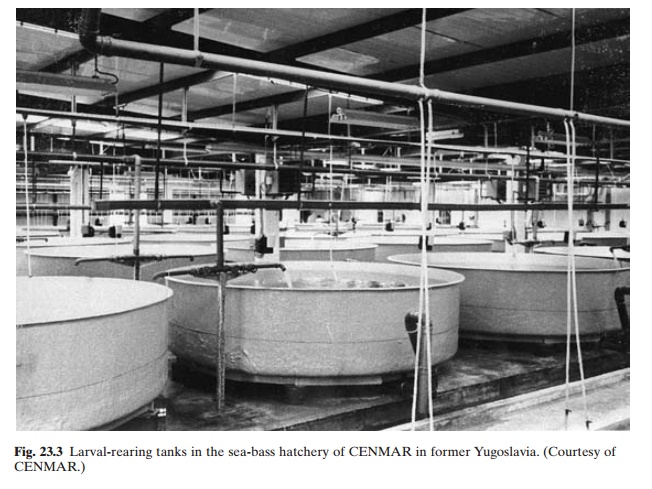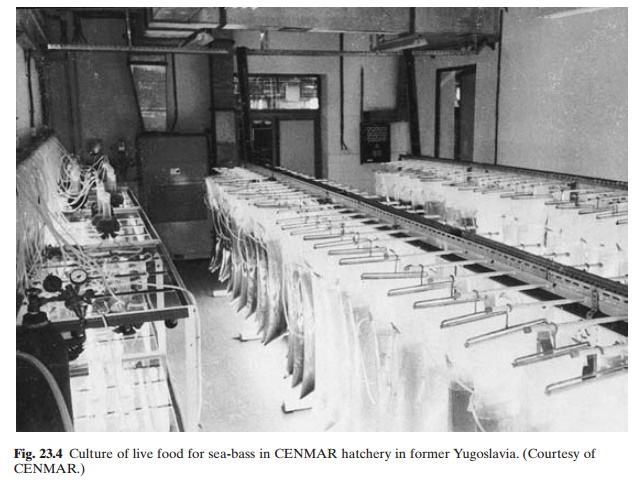Chapter: Aquaculture Principles and Practices: Sea-Basses and Sea-Breams
European sea-bass
Sea-basses
The main handicap to the introduction of intensive culture of the European sea-bass Dicentrarchus labrax and the Asian sea-bass Lates calcarifer has been the lack of dependablesource of fry and fingerlings. Though wild fry can be collected from natural habitats, the supply is highly inconsistent and inadequate. Because of this, many recent scientific studies

European sea-bass
Dicentrarchus labrax has been induced tospawn by the administration of different hormone preparations. Natural spawning has also been obtained in captivity without any hormone injections. Girin (1976) reported spontaneous spawning of mature fish in sea-water tanks (salinity 35ppt), with complete renewal of water every 10 hours. Injections of carp pituitary homogenates and HCG have been successfully used to induce spawning. According to Barnabe (1976), HCG in doses of 800IU/kg body weight is much more effective than carp pituitary in induced breeding of this species. As in many other species, the best results are obtained by administration of the dose in two injections at intervals of one or two days. Spawning usually takes place about three days after treatment.The average number of eggs spawned annually is reported to be 300000/kg body weight and each egg measures 1.2–1.4mm in diameter. Different types of incubators have been used for hatching the eggs. The salinity of the water supply is maintained around 34–35ppt and the temperature around 13°C, when the pelagic eggs become demersal. The incubation period naturally depends on temperature and varies from 166 to 47 hours at temperatures ranging from 11 to 19°C, but the optimum temperature is believed to be 13°C. Very high hatching rates, nearing 90 per cent, have been reported (Barnabe, 1976).
The newly hatched larvae measure about 3.5mm in length and the yolk sac is absorbed by the fourth or fifth day, depending on temperature. If sufficiently large incubators are used, the larvae can be reared for longer periods, with adequate aeration and feeding. Alternatively, they can be transferred to larger larval rearing tanks, with controlled water quality (fig. 23.3).

A temperature of 14–20°C, salinity of 34– 37ppt, pH of 7.9–8.2 and oxygen levels of 6–9m/l are the recommended environmental requirements. Aeration and regular water renewal together with a temperature slightly higher than ambient help improve larval growth. Various types of larval feeds have beentried in experimental hatcheries, with varying results (fig. 23.4). It appears clear that in the early stages the larvae require live food, such as Brachionus, Artemia and copepods. A feedingsequence suggested by Girin (1976) comprises Brachionus from the fourth to the fourteenthday, Artemia nauplii from the eleventh to the fiftieth day, 1mm size Artemia from the twenty-fifth to the fiftieth day, 2mm size Artemia from the fortieth to the fiftieth day, frozen Artemia from the fiftieth to the sixtieth day, and there-after mixed food including lyophilizedArtemia to the seventy-sixth day. A simpler schedule of feeding consisting of live food (Brachionus and Artemia) up to 35 days, followed by a 52 percent protein pelleted feed containing about 10 per cent Artemia, has been found to be adequate (Barahona and Girin, 1976). Cannibalism among fry can be a major problem, and so the fry have to be frequently graded and separated according to size to minimize losses.

Seventy-five- to eighty-day-old fry, which measure about 40mm, are transferred to cages for on-growing. The optimum density is reported to be below 20kg/m3. The minimum market size is about 250g, and in extensive systems in temperate areas it may take as long as two years for them to reach that size. During the third year they can reach 500g, and 1kg in the fourth year. Much better growth rates have been obtained in floating cages, when feeding balanced compound feeds. In a pilot farm in Yugoslavia an average weight of 300g was achieved in 18 months. In Israel, where D.labrax has been tried as a predator in fresh-water tilapia ponds, fish of 230–300g size grew to 650–780g in about seven months. In experimental recirculating systems in Denmark, with controlled temperature (between 22 and 25°C), the fish are reported to have grown to 300– 500g within one year.
There are few records of disease causing high mortality in sea-bass culture systems. Out-breaks of vibrio infections are reported to have caused mortality in a pilot farm in Yugoslavia.
Related Topics